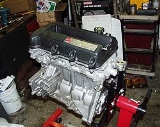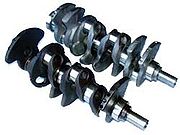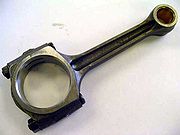
Saturn I4 engine
Encyclopedia
The powerplant used in Saturn S-series
automobiles was a straight-4
aluminum piston engine produced by Saturn, a subsidiary of General Motors
. The engine was only used in the Saturn S-series line of vehicles (SL, SC, SW) from 1991 through 2002. It was available in chain-driven SOHC or DOHC variants.
This was an innovative engine for the time using the lost foam casting process for the engine block and cylinder head. Saturn was one of the first to use this casting process in a full-scale high-production environment. Both engine types used the same engine block.
The LK0 engine first used TBI (Throttle Body Injection) for fuel delivery and was rated at 85 hp (63 kW) and 110 ft·lbf (149 N·m) of torque from 1991 to 1994.
The L24 engine received MPFI (Multi-Port Fuel Injection) in 1995 which increased power output to 100 hp (75 kW) and 114 ft·lbf (155 N·m). This engine was used from 1995 to 2002.
The SOHC engine was available on the base model S-series vehicles (SC1, SL, SL1, SW, SW1)
1992 through 1998 L24 Cylinder heads developed issues with cracks developing in the fifth camshaft journal, located closest to #4 cylinder. The hairline crack would develop between the oil feed port of that journal and the coolant passages in the cylinder head. Symptoms would range from overheating to to low coolant, however, most cars affected by this issue exhibited oil migration into the cooling system. The resulting mixture of the two fluids would result in a thick brown "milkshake"-like mixture, visible in the coolant overflow tank.
Saturn released unadvertised policy which would cover this issue, extending the warranty on the cylinder head to 6 years or 100,000 miles (160k km).
Repair required the replacement of the cylinder head. and flushing of the coolant system. Badly affected cars would see coolant in the oil, as well as oil in the coolant, and would require the replacement of the complete engine assembly.
Until the cylinder head casting was redesigned some time in 1998, some vehicles would require this repair more than once, and replacement cylinder heads could develop the same crack.
It was estimated that between 2% and 5% of SOHC Saturn S-Series vehicles were affected by this defect. DOHC engines had a different cylinder head, and did not suffer the same issue.
LLO cylinder heads were changed slightly in 1995, when Saturn adopted electronic, linear EGR mechanisms, over the previous vacuum actuated design. The head casting was changed to accommodate different mounting surface of the new valve.
All LLO engines used MPFI and were rated at 124 hp (92.5 kW) and 122 ft·lbf (165 N·m). The DOHC engine was available on the upper-level model S-series vehicles (SC, SC2, SL2, SW2). A revision of the LL0 appeared in 1999 and used a roller camshaft with hydraulic lifters and rocker arms




Saturn S-series
The S-Series was part of a family of compact cars from the Saturn automobile company. This was the first series of Saturn vehicles. The automobile platform, the Z-body, was developed entirely in-house at Saturn and shared very little with the rest of the General Motors model line...
automobiles was a straight-4
Straight-4
The inline-four engine or straight-four engine is an internal combustion engine with all four cylinders mounted in a straight line, or plane along the crankcase. The single bank of cylinders may be oriented in either a vertical or an inclined plane with all the pistons driving a common crankshaft....
aluminum piston engine produced by Saturn, a subsidiary of General Motors
General Motors
General Motors Company , commonly known as GM, formerly incorporated as General Motors Corporation, is an American multinational automotive corporation headquartered in Detroit, Michigan and the world's second-largest automaker in 2010...
. The engine was only used in the Saturn S-series line of vehicles (SL, SC, SW) from 1991 through 2002. It was available in chain-driven SOHC or DOHC variants.
This was an innovative engine for the time using the lost foam casting process for the engine block and cylinder head. Saturn was one of the first to use this casting process in a full-scale high-production environment. Both engine types used the same engine block.
Engine block
The engine utilized a water-cooled aluminum block. The main bearing caps were made of cast iron and held in place with two bolts each. The cylinder block bores had interference fit cast iron liners for the piston rings to sit against. The engine block was made from 319.1 aluminum alloy and the liners were made from D5506 ductile iron.Crankshaft
The crankshaft was supported by five main bearings with thrust taken at the middle bearing. 1991 and 1992 engines had a different crankshaft than 1993 and later engines. 1993 and later crankshafts had ten degrees advanced reluctor ring slots to aid in startability. 1991 to 1998 crankshafts incorporated 4 counterweights. 1999 to 2002 crankshafts incorporated 8 counterweights.Connecting rods and pistons
From 1991 to 1998 the connecting rods were forged steel with standard type crank pin bearings. The piston pins floated in the connecting rod bushings. The pistons were cast aluminum alloy with the piston pins being retained with snap rings.Timing chain
The timing chain was hydraulic tensioned and had a ratchet mechanism to keep the chain tight. The timing chain rode on one pivoting chain guide resting on the ratchet tensioner and one fixed guide attached to the engine block and cylinder head. The 1991 to 1998 DOHC engine had an upper timing chain guide in between the camshaft sprockets. The timing chain was lubricated via cast-off from the top of the cylinder head and one 'squirter' on the oil pump housing. The SOHC and DOHC engines used different timing chain sets.SOHC LK0/L24
The SOHC (LK0/L24) cylinder head had 8 valves and was made of lost foam cast aluminum. The camshaft was located in the center of the cylinder head and driven by a chain off the front crankshaft sprocket. Motion from the camshaft was transmitted to the eight valves by the hydraulic lifters and rocker arms.The LK0 engine first used TBI (Throttle Body Injection) for fuel delivery and was rated at 85 hp (63 kW) and 110 ft·lbf (149 N·m) of torque from 1991 to 1994.
The L24 engine received MPFI (Multi-Port Fuel Injection) in 1995 which increased power output to 100 hp (75 kW) and 114 ft·lbf (155 N·m). This engine was used from 1995 to 2002.
The SOHC engine was available on the base model S-series vehicles (SC1, SL, SL1, SW, SW1)
1992 through 1998 L24 Cylinder heads developed issues with cracks developing in the fifth camshaft journal, located closest to #4 cylinder. The hairline crack would develop between the oil feed port of that journal and the coolant passages in the cylinder head. Symptoms would range from overheating to to low coolant, however, most cars affected by this issue exhibited oil migration into the cooling system. The resulting mixture of the two fluids would result in a thick brown "milkshake"-like mixture, visible in the coolant overflow tank.
Saturn released unadvertised policy which would cover this issue, extending the warranty on the cylinder head to 6 years or 100,000 miles (160k km).
Repair required the replacement of the cylinder head. and flushing of the coolant system. Badly affected cars would see coolant in the oil, as well as oil in the coolant, and would require the replacement of the complete engine assembly.
Until the cylinder head casting was redesigned some time in 1998, some vehicles would require this repair more than once, and replacement cylinder heads could develop the same crack.
It was estimated that between 2% and 5% of SOHC Saturn S-Series vehicles were affected by this defect. DOHC engines had a different cylinder head, and did not suffer the same issue.
DOHC LL0
The DOHC cylinder head had 16 valves and was made of lost foam cast aluminum. The camshafts were held in the cylinder head with bearing caps and driven by a chain off the front crankshaft sprocket. Motion from the camshafts was transmitted to the 16 valves by direct-acting hydraulic lifters.LLO cylinder heads were changed slightly in 1995, when Saturn adopted electronic, linear EGR mechanisms, over the previous vacuum actuated design. The head casting was changed to accommodate different mounting surface of the new valve.
All LLO engines used MPFI and were rated at 124 hp (92.5 kW) and 122 ft·lbf (165 N·m). The DOHC engine was available on the upper-level model S-series vehicles (SC, SC2, SL2, SW2). A revision of the LL0 appeared in 1999 and used a roller camshaft with hydraulic lifters and rocker arms
Images





